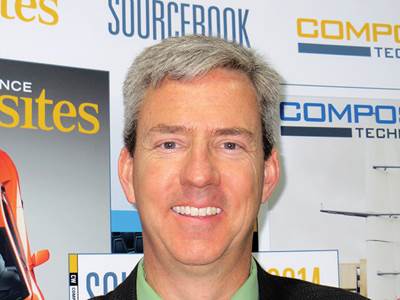Accelerating the certification process for aerospace composites
Columnist Byron Pipes foresees the certification of simulation software in place of physical testing.
The continued growth of the composites enterprise demands more rapid development of products and services to meet the growing needs of an energy-efficient society. To meet this challenge, manufacturing technology based only on past experience must give way to new paradigms, guided by simulation of complex phenomena that are discovered and then codified in a timely way. Design for performance and manufacturability (but not manufacturing phenomena) has long been well-grounded in computer simulations that, today, can develop a product’s “virtual twin.” This approach can lead to products that meet or exceed performance requirements, but can also result in product designs that neglect manufacturing optimization, with an undesirable outcome in product economics. Further, more often than not, suppliers do not have access to the sophisticated simulation toolsets used by the OEMs they serve. Real progress, then, calls for new protocols and systematic development of software-based composites simulation tool suites that are then shared by both OEMs and their supplier communities.
Unfortunately, the certification of aerospace composite products for human flight is still driven by exhaustive experimental testing, without the full benefit of simulation. This approach significantly increases the cost of product development, retards the development of new material systems and limits aerospace product diversity. Major aircraft OEMs spend millions of dollars and allocate thousands of man-hours annually to test and retest designs for certification. That testing is further extended when a design change comes into play. For maintenance and repair organizations (MROs), the certification process can be even more complex because the nature of repair is unpredictable and in-field remanufacturing is quite different from factory production.
Once the design is complete, the exhaustive physical testing begins. Whether the flight structure is made up totally or partially of composites, the current certification process is time-consuming, manual and expensive for OEMs. The current process is designed to reduce risk, but it is not optimized to minimize costs and time to completion. One problem is that the software tools used today for design and manufacturability are often disconnected and not based on the same platform — a necessary prerequisite for intercode communication. Furthermore, when the OEMs hand off the design to their supply chains to test and/or build the components, it is likely that the suppliers do not have access to the same simulation toolset as the OEM. This, too, increases the cost and complexity of the evaluation and manufacturing processes. In many cases, the component design given to the supply chain is focused solely on product performance and the part has not been designed for manufacturability. Because the design is typically frozen at this stage, the materials and the manufacturing approach have already been selected. In addition, there are many other constraints placed on the supplier that must be adhered to during the fabrication process. All these restrictions can significantly limit innovation within the supply chain.
If OEMs and their suppliers shared the same specialized design and manufacturing software, the development lifecycle could be shortened, with a decrease in development cost, while allowing more time for innovation by all. Further, the composites simulation tool suite could be used as the platform for the certification of composite structure as well. Here, again, composites simulation tools can provide an economic alternative to exhaustive studies of process and performance variability. But to do so, simulation tools for prediction of manufacturing and performance variability must be developed and then integrated into the certification process.
The most direct approach to reducing the cost and time of product certification is to first certify the simulation tools themselves. Certified simulation tools could be used by engineers with the expectation that, within the bounds of the certification, no further verification or validation would be necessary. This would result in enormous savings because the contemporary approach involves verification and validation testing by each user before the simulations can be trusted.
Certification of composites simulation tools might not be a simple undertaking, however. First the taxonomy of the code must be clearly developed. The scientific principle, scale and level of homogenization, specific mechanism, solution form approximation, computational efficiency, communication compatibility and maturity level must be determined in the taxonomy of each tool. Next, a rigorous process for verification and validation within clearly specified conditions must be developed and articulated.
Before simulation tools can be certified, their maturity level must be assessed. An innovative construct for this purpose, Tool Maturity Level (TML), has been proposed by Cowles, Backman and Dutton1.
TML has been defined at five levels:
- TML1) The first-level simulation tools are based on analytical processes that are exploratory in nature. Fidelity of predictions at this level is largely unproven, but predictions can provide some physical insight, while they cannot reduce development testing.
- TML2) At the second level, the simulation tool is proven for comparative assessment, ranking or trending. Experimental validation is still necessary, and tools at this level can drive development or the assessment plan and test matrix.
- TML3) For tools at the third level of maturity, the material or process can be developed or assessed with significantly reduced testing. There is the expectation that development iterations can be reduced or eliminated at this level. However, accuracy and uncertainty must be quantified experimentally, and the range of applicability must be well-defined.
- TML4) At the fourth level, the material or process performance and impact on system or application are well understood. Accuracy and uncertainty effects must still be verified. Additional data might be required when the software is applied to new materials or processes, or to extend the range of application.
- TML5) The fifth tool maturity level is for simulation tools in which all material and process performance and system interaction effects are understood within the defined range of application, and the tool can be applied without further testing.
Because variability drives certification, two additional levels of tool maturity are proposed:
- TML6) Level six is for tools where all material and process performance variability and system interaction effects are understood within the defined range of application.
- TML7) The highest level of maturity, consistent with simulation tool certification, is an analytical process that can be applied to predict variability distribution without testing. Thus, prediction of performance or manufacturing variability with the same level of confidence as experimental testing must be the long-term objective of this undertaking.
Finally, the cost of advanced composites simulation has been an important point of concern within the composites community even for OEMs, but cost and competency in use may well be the primary barriers to supplier adoption. However, two positive forces for cost reduction are of growing importance: scale of use and competition. The significant growth in the use of simulation and competition among the diversified simulation product/service suppliers will reduce cost and should lead the way to enhanced efficiency in use.
At the end of the day, the level of confidence in more economical prediction of composite manufacture and performance variability at the component level, and for the entire vehicle, can only come from a systematic development of new protocols, new use and development of suites of integrated simulation tools, and from a user community that possesses the maturity and sophistication to use this new paradigm to meet the growing needs of an energy-efficient society. In my opinion, “the view will be worth the climb!”
Reference:
1Cowles, B., Backman, D. and Dutton, R. “Verification and validation of ICME methods and models for aerospace applications,” Integrating Materials and Manufacturing Innovation, (2012), 1:2, www.immijournal.com/11/2.
Related Content
Materials & Processes: Resin matrices for composites
The matrix binds the fiber reinforcement, gives the composite component its shape and determines its surface quality. A composite matrix may be a polymer, ceramic, metal or carbon. Here’s a guide to selection.
Read MoreA new era for ceramic matrix composites
CMC is expanding, with new fiber production in Europe, faster processes and higher temperature materials enabling applications for industry, hypersonics and New Space.
Read MorePEEK vs. PEKK vs. PAEK and continuous compression molding
Suppliers of thermoplastics and carbon fiber chime in regarding PEEK vs. PEKK, and now PAEK, as well as in-situ consolidation — the supply chain for thermoplastic tape composites continues to evolve.
Read MoreMaterials & Processes: Fibers for composites
The structural properties of composite materials are derived primarily from the fiber reinforcement. Fiber types, their manufacture, their uses and the end-market applications in which they find most use are described.
Read MoreRead Next
One for the history books?
HPC editor-in-chief Jeff Sloan wonders if a current and radical proposal for change in the way aerospace materials and processes are certified — namely, certification of design/simulation software — will find the brave advocates it will need to become a watershed in aerocomposite history.
Read MoreOne for the history books?
HPC editor-in-chief Jeff Sloan wonders if a current and radical proposal for change in the way aerospace materials and processes are certified — namely, certification of design/simulation software — will find the brave advocates it will need to become a watershed in aerocomposite history.
Read MoreOne for the history books?
HPC editor-in-chief Jeff Sloan wonders if a current and radical proposal for change in the way aerospace materials and processes are certified — namely, certification of design/simulation software — will find the brave advocates it will need to become a watershed in aerocomposite history.
Read More















.jpg;maxWidth=300;quality=90)






